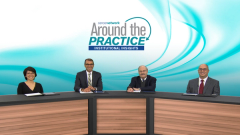
Selecting the Optimal Therapy for Patients With Transplant-Ineligible NDMM
Comprehensive discussion on the array of treatment regimens available for patients with transplant-ineligible NDMM and how best to sequence therapy.
Episodes in this series

Transcript:
Alfred Garfall, MD: If we rewind to the choice of initial therapy for this patient, there were signs of not going on to transplant, and we talked about whether that decision should be made early. Though there’s a lot of medical comorbidity, and this decision was not made at our center necessarily, there is VRd [bortezomib, lenalidomide, dexamethasone]-lite versus where the patient eventually landed, which was daratumumab and lenalidomide. How do you sort that out? We’ve talked about the data around traditional VRd, but VRd-lite versus daratumumab and lenalidomide and dexamethasone for someone with this profile.
Dan Vogl, MD: It’s interesting because I think our categorization of therapies according to transplant-eligible and transplant-ineligible patients dates back to the time when the standard of care for older patients with myeloma was an oral melphalan-based regimen, which would then make it hard to collect stem cells and go on to transplant. Since we showed that lenalidomide and dexamethasone was at least equivalent and probably superior to melphalan, prednisone, and thalidomide, and we’ve abandoned the oral melphalan, the distinction doesn’t really matter as much, which is why we don’t necessarily have to label the patient as transplant eligible or transplant ineligible when we first see them. For this patient it was important to acknowledge that she had a lot of comorbidities at the time of presentation, and a really high risk of complications, not just from neuropathy, but from fluid retention, especially from the steroids and the bortezomib. There are all sorts of complications you can see also with lenalidomide, especially when given in the setting of renal insufficiency.
The idea of using a dose-attenuated regimen and making sure that the initial bortezomib dosing is weekly instead of twice weekly, and lowering the lenalidomide dose, being really careful about steroid dosing, does make for a tolerable regimen for many patients. I think it’s true that the daratumumab, lenalidomide, dexamethasone regimen has less toxicity than the bortezomib combination because daratumumab is so well tolerated. For my especially frail patients, I will definitely choose to leave out the bortezomib and include daratumumab instead. For patients who have a reasonable performance status at the time you’re starting therapy, I don’t think it’s wrong to use the bortezomib-based regimen because if you’re observing carefully, to me the key for this case was noticing after the first cycle that the patient was developing a painful peripheral neuropathy and changing therapy immediately. Because the worst thing you can do is to stick to the regimen despite emerging toxicity when there are good alternatives.
Alfred Garfall, MD: Thanks. We don’t have the cytogenetic risk characterization from this patient, but the patient had an elevated beta-2 microglobulin at baseline, and there has been some reluctance to omit bortezomib from the initial therapy of “high-risk patients.” That has a tortured history I guess, the clinical trial data. I wonder if it might be worth spending a bit of time on this kind of risk-adapted approach and whether that’s sensible, and particularly whether a high-risk status or particular cytogenetic abnormality should funnel patients to one or the other of these options. Is that rooted in evidence, or should we just think about particular comorbidities and adverse effect profiles and tolerances of these medications in and of themselves?
Edward Stadtmauer, MD: I think the issue of bortezomib comes from one of the oldest studies, the APEX study, where we randomized patients to dexamethasone versus bortezomib and dexamethasone, and found that the patients who had 14th chromosome abnormalities did better. This was a high-risk feature, and the addition of bortezomib seemed to alleviate the high-risk-ness of that feature. I don’t think the data are very strong in terms of, if you don’t give bortezomib in the current era to these groups of patients, that those patients do worse. I don’t think there are a lot of strong data that way, so I don’t think that’s the way to make the decision. On the other hand, as Dan was saying, most patients with dose-adjusted and frequency-adjusted bortezomib can tolerate that as long as you’re very sensitive to the development of neuropathy, and either reduce the dose or discontinue the medication when that starts happening.
Dan Vogl, MD: In some ways, it’s important to keep in mind that the decision of what to give first to a patient does not necessarily mean that’s the only thing they’re going to get. We have very little comparative information that would tell us the best combinations and sequences of therapy. So, arguing about whether a patient needs to get bortezomib because of their cytogenetic risk as part of their initial therapy ignores the fact that if they’re not going to get bortezomib as part of first-line therapy, there’s a very high chance they’re going to get bortezomib as part of second-line therapy. And the same applies for daratumumab. If you’re not going to use it as part of first-line therapy, you’re very likely to use it as part of second-line therapy. The trickier question is, when is the optimal time to use these agents for each individual patient? And I agree with that. I don’t think we have clear clinical trial data to guide those decisions based on cytogenetic risk profile at the time of diagnosis. I think we can decide based on the patient’s clinical characteristics, their burden of disease, their risk of getting particular adverse effects, to individualize the therapy for the patients on that basis.
Edward Stadtmauer, MD: I agree, Dan. I think potential toxicity is probably higher on the list of how we should choose our regimens than biological characteristics. This patient had cardiac issues, which is an interesting area, because we know that the proteasome inhibitors as a class do have a few more [cardiac-related] issues, both how to adjust the doses as well as potential toxicities. Renal insufficiency of course is key. Those 2 characteristics I think are key in our decision-making of regimens and doses for these patients.
Alfred Garfall, MD: Thanks. Were you going to say something, Sandara?
Sandara Susanibar-Adaniya, MD: Yes. What I wanted to point out is that in the studies, when they do the post-hoc analysis and they separate between groups, you can see that standard-risk and high-risk patients all respond. The problem comes with the follow-up. The high-risk patients tend to relapse quicker. I think that should also make us be more vigilant when we’re observing our patients. As Dan and Ed mentioned, in the follow-up when you see that those patients respond but then they plateau, maybe their myeloma markers start creeping back up, then you must pay attention and not wait too long to add another medication that will be safe and very well tolerated.
Alfred Garfall, MD: I think what you’re hearing is that it’s really important to pay attention to patients’ clinical courses longitudinally, and stress less about these initial decisions, but have more attentiveness over time, both with the toxicity and response. I feel like, what I tell my patients more and more, because there’s a lot of stress even among patients about how to choose these, is that we’ve improved outcomes for patients with multiple myeloma by having more and more drugs. It’s important for patients to receive all these therapeutic classes at some point in their time with the disease. We’re going to try to order and sequence them in the most logical fashion for their clinical condition, but the most important thing is that they get exposure to these really important and potent drugs at some point. Fortunately, all of them have sufficient activity that we really are able to imagine multiple lines of therapy for our patients, where maybe back in the day when those first transplant versus no transplant studies were undertaken, you had 1 line of therapy for patients with multiple myeloma and that’s it.
Transcript edited for clarity.
Newsletter
Stay up to date on recent advances in the multidisciplinary approach to cancer.




































































































